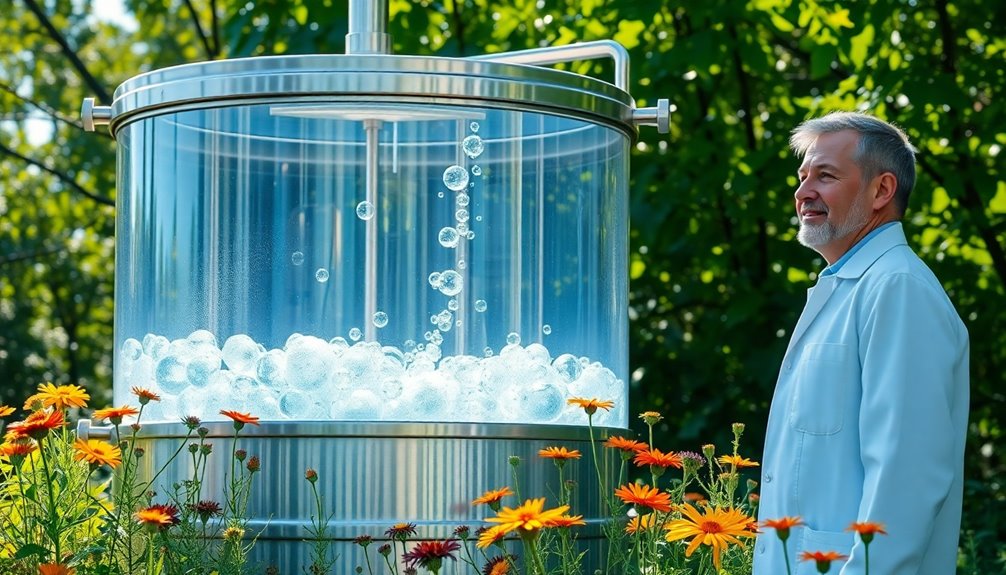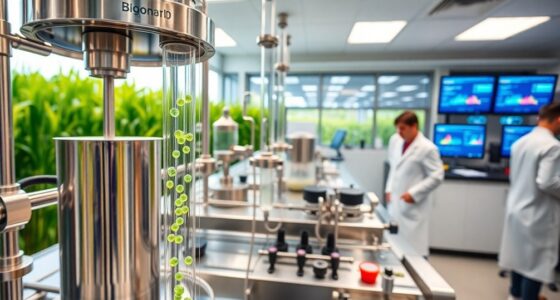You'll find that eco-friendly methane-to-ethanol conversion methods are making great strides in sustainable energy. These innovative techniques, like photocatalytic and electrochemical processes, operate efficiently under mild conditions. They achieve impressive selectivity and conversion rates while supporting carbon neutrality goals. By enhancing ethanol production, you're looking at a green alternative that's perfect for urban transport. There's more to discover about the exciting advancements in this field.
Key Takeaways
- Photocatalytic conversion using CTF-1 polymers operates at ambient conditions, achieving an 80% selectivity in methane conversion.
- Electrochemical techniques with Cu2O/CuO provide low-energy operation and scalability, achieving a Faraday efficiency of 21.1%.
- Enhanced ethanol production rates are observed with platinum addition in photocatalytic processes, marking significant advancements in technology.
- These methods align with global carbon neutrality goals, supporting sustainable energy and eco-friendly initiatives.
- Ethanol produced can serve as a practical liquid hydrogen carrier for urban transport and various applications.

As the global push for sustainable energy sources intensifies, the conversion of methane into ethanol presents an innovative solution that not only taps into an abundant carbon resource but also aligns with carbon neutrality goals. Methane, being a prevalent carbon source, offers immense potential for chemical synthesis. However, its chemical inertness poses significant challenges for efficient conversion. Traditional methods often require high temperatures and pressures, making them energy-intensive and less selective, leading to unwanted byproducts.
New eco-friendly methods are emerging to tackle these challenges. For instance, photocatalytic conversion using covalent triazine framework (CTF-1) polymers allows for methane conversion at ambient conditions, drastically reducing energy requirements. This method achieves approximately 80% selectivity and a methane conversion rate of 2.3%, demonstrating an impressive apparent quantum efficiency of 9.4%. Furthermore, adding platinum can further enhance ethanol production rates, making the process more efficient. Notably, this innovative approach represents a significant step-change in the photocatalytic conversion of methane.
Emerging eco-friendly methods, like photocatalytic conversion with CTF-1 polymers, significantly enhance methane to ethanol efficiency and selectivity.
In contrast to traditional methods, these innovative techniques save energy by operating under mild conditions. They not only boost quantum efficiency but also improve selectivity for ethanol, minimizing byproducts and reducing the carbon footprint. This alignment with the increasing demand for sustainable chemical feedstocks makes the process appealing in the current market, where the global ethanol sector exceeds USD 100 billion annually.
Electrochemical conversion methods using materials like Cu2O/CuO are also gaining traction. These methods operate effectively under low-energy conditions, achieving a Faraday efficiency of 21.1%, which can rise to 69.2% at higher pressures. With production rates reaching 441.3 μmol g cat–1 h–1, their scalability becomes evident, paving the way for large-scale application.
Ultimately, converting methane to ethanol not only supports carbon neutrality goals but also positions ethanol as a practical liquid hydrogen carrier, suitable for urban transport and various applications. This promising avenue showcases the potential for a sustainable energy future, aligning with both environmental initiatives and market demands.
Frequently Asked Questions
How Does This Method Compare Cost-Wise to Traditional Ethanol Production?
When you compare the cost of methane-to-ethanol conversion to traditional ethanol production, you'll find significant differences.
Traditional methods require high energy inputs and substantial feedstock costs, which can add up quickly.
In contrast, methane conversion can potentially lower production costs by utilizing waste methane and improving efficiencies.
If scaled effectively, you might see competitive pricing, especially as green energy demand rises and technology advances, making it a compelling option for the future.
What Are the Potential Environmental Impacts of This Conversion Process?
When you consider the potential environmental impacts of converting methane to ethanol, you'll notice significant benefits.
This process reduces methane emissions, which are potent greenhouse gases. Ethanol, as a cleaner-burning fuel, lowers overall emissions compared to fossil fuels.
Plus, it's less toxic and biodegradable, enhancing safety in case of spills. By utilizing waste materials, you also help manage waste more effectively, contributing to a more sustainable future.
Can This Technology Be Adapted for Small-Scale Applications?
Imagine a compact garden where small plants thrive under the sun, just like technology adapting for small-scale applications.
You can harness methane conversion methods designed for modular setups, making it easier to implement in various locations.
By utilizing photocatalytic techniques, you reduce energy needs and infrastructure costs.
With innovative catalysts and scalable designs, you can achieve efficient, localized operations, turning waste into valuable products while minimizing environmental impact.
What Are the Main Challenges in Implementing This Method Commercially?
When considering the commercial implementation of methane-to-ethanol conversion, you'll face several challenges.
First, energy efficiency and catalyst durability must be ensured for long-term use. Scalability from lab to industry is complex, and high material costs can strain budgets.
Economically, you'll need to compete with established processes and navigate fluctuating market demands.
Additionally, adhering to regulatory standards and managing environmental impacts will play a crucial role in your project's success.
How Does Methane Capture Influence the Overall Efficiency of the Process?
When you think about the air we breathe, consider how methane capture dramatically boosts efficiency in the conversion process.
By effectively capturing methane, you minimize leaks and maximize recovery, leading to higher ethanol yields. The quality of your methane feedstock matters too; purer methane enhances the overall outcome.
Plus, with new techniques operating at ambient conditions, you'll see reduced energy needs, making the process not just efficient but also more environmentally friendly.
Conclusion
In this innovative eco-friendly method, methane transforms into ethanol like a caterpillar emerging from its chrysalis, symbolizing a fresh start for our energy sources. This breakthrough not only reduces greenhouse gas emissions but also paves the way for a sustainable future. As you witness this metamorphosis, you'll see the potential for cleaner fuels illuminating our path, encouraging us to embrace change and nurture our planet. Together, let's cultivate this green revolution and reap the benefits for generations to come.









